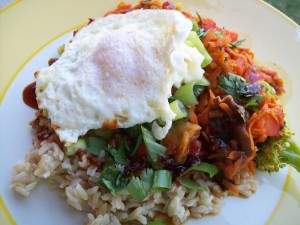 Say it with me, friends: Bibimbap.
Say it with me, friends: Bibimbap.
Bibimbap. Bibimbap. Or, as my kids so charmingly suggested, “Bibbidi-bobbidi-boo?”
It doesn’t really matter what you call it. This meatless wonder of a meal was a completely unexpected hit with the whole family, and it hit all the right notes for a weeknight dinner: Easy, healthy, tasty, and cheap. As the summer produce begins to heat up around here, I’ll certainly be making this again, with different variations on the vegetables I used to test the recipe. That’s another beauty part about this dish – there’s no one right way to make it. Essentially, this is a dressed-up, better-for-you fried rice recipe, which you can personalize with any mix of vegetables (and even meat or seafood, if you insist) that makes you happy. In my book, that would be the ones that are most abundantly and clamoringly in season. You can’t screw up the taste of an in-season vegetable.
Somebody is sure to write to me after seeing this recipe and complain that it’s not authentic, and I am okay with that. I will be very honest and up front with you all by saying that I have a very dim grasp of what authentically ought to be in a bibimbap recipe. I’ve looked at a few, and there are some commonalities, but not many. I’ve eaten bibimbap once, in a restaurant, but that didn’t help me much. So really, what you’ll find here is my version of this budget-friendly dish, modified so that it’s easy enough for the average frazzled human being to pull it off in a home kitchen.
Sadly, I had to do away with one of the key components of the dish in its authentic form. Traditionally, you’d find bibimbap served in a special heated vessel that makes the rice all crunchy around the outsides. For a home kitchen, that sort of innovation (and extra step) didn’t seem quite right, so I scrapped it; but you could probably bake the whole thing in a casserole for a while if you felt the need to experience the crunchy rice phenomenon. I found that the meal was absolutely delicious as it was, without the crusty exterior, so I don’t think you’ll be missing anything if you opt out. But you do what you like.
As for the sauce: Some of you will wonder what in the world I’m doing advocating that you use oddball ingredients like miso paste and sambal. I don’t ordinarily post recipes on RRG that require you to buy a bunch of fancy pantry dust-collectors. However, neither sambal nor miso paste is dreadfully expensive, they both last FOREVER in the fridge, and once you’ve got them, they’re not hard to use. A little miso paste stirred into hot broth with garlic, ginger, and seaweed makes an easy miso soup. It can also be used in salad dressings, stir-fries, and marinades. Sambal is just chiles with garlic and ginger, so used sparingly, it’s a good condiment in its own right, or can be used to start sautes and stir-fries or liven up soups and sauces.
I swear, this is a meatless meal worth trying. J. even said to me, “I have to be honest: I don’t expect that anything you make will be BAD, but I wasn’t very excited about this idea. I was wrong. It’s awesome. It’s really, really good.” He and the boys both devoured their dinners when I set this in front of them, with not a single comment about the lack of meat. In my house, that’s high praise, indeed.
Get the recipe: Vegetarian Bibimbap

Leave A Comment